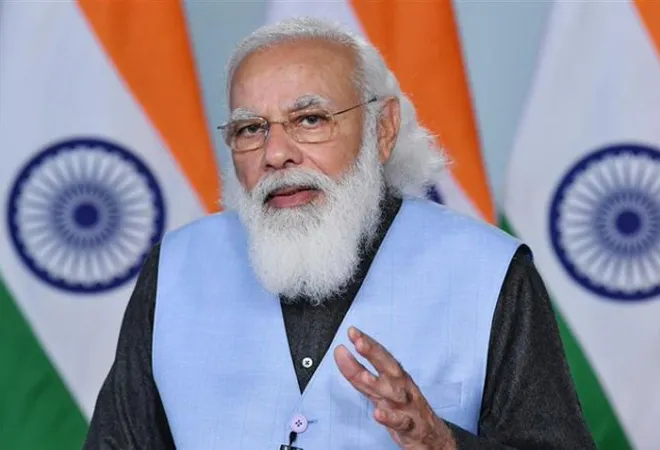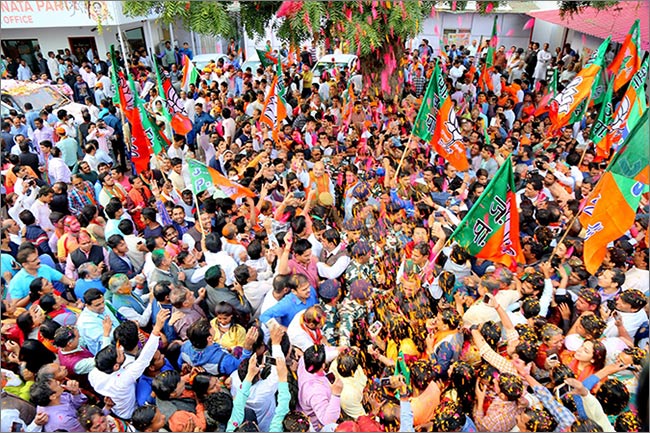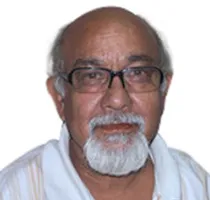
The Bharatiya Janata Party won a huge victory in the States of Uttar Pradesh and Uttarakhand but remained second in Goa and Manipur while it lost Punjab along with its old ally Shiromani Akali Dal in the just concluded Assembly elections.
Prime Minister Narendra Modi’s credibility as well as his charisma along with the organisational skills of party president Amit Shah resulted in the convincing victory in the two States of the Hindi heartland. Modi-Shah combine has also helped the party spread its reach to Manipur in the north east of the country. The defeat in Punjab is more because of the sins of its alliance partner, the Shiromani Akali Dal, than its own faults. Goa was the only exception where the Mod-Shah magic did not work as the BJP lost almost its cabinet ministers, including the chief minister, and the Congress emerged as the single largest party winning 17.
The BJP got two-third majority in the UP and Uttarakhand. In UP, it got a huge popular mandate of over 310 seats while its rivals – the SP-Congress alliance and the BSP -- were routed, coming a dismal second and third positions respectively.
The victories came because of an intelligent and crafty combination of religion and caste-based identity politics -- popularly known as Kamandal and Mandal -- that had led to the growth of the BJP and a couple of caste based regional parties in the last two decades of the 20th century.
A deadly cocktail of ‘Kamandal’ and ‘Mandal’ matured over time after picking up still relevant elements of the two and attractively packaged in the garb of development propagated by the oratorical skills swept the UP and Uttarakhand electorate off their feet and the BJP managed to get two-third majorities in two States. The same did not work in Punjab because of the strong anti-incumbency against 10 years of the SAD-BJP government.
Factors that contributed to such a convincing mandate in UP might be many, but primarily it won because of Modi’s continuing sway over the electorate that began in 2014. Sharp communal polarisation took place because of its rivals’ over emphasis on Muslim votes and Hindu’s reverse reaction. Some other reasons are consolidation of non-Yadav OBCs and non Jatav Dalit electorate in BJP’s favour and the anti-incumbency against Chief Minister Akhilesh Yadav’s government because of the domineering presence of Yadavs in the state administration and rising crime along with bad law and order situation.
The BJP and Modi highlighted the discrimination against non-Yadav OBCs as majority of government posts as well as positions went to Yadavs and some to Muslims. The Prime Minister was not shy of telling the electorate in his meetings and rallies that Hindus had no place in the SP government while Muslims were being favoured. This feeling was deeply etched in the popular minds when the SP and the Congress went into an alliance to avoid the division of Muslim votes and BSP supremo Mayawati gave over 100 seats to Muslim candidates.
The BJP also sharpened the communal tensions in western UP, which had faced communal riots in 2013, by fielding firebrand Hindu leader Yogi Adityanath, a BJP MP from Gorakhpur. He went on telling that UP was going to turn into Jammu and Kashmir.
Every single leader of the BJP went around telling that Muslims were responsible for terror. A negative environment was already prevailing in these areas. Slogans of love jihad and alleged migration of Hindu population from some parts of western UP had contributed to it. The BJP’s decision of not fielding a single Muslim candidate gave a direct message to Hindu population that the party truly represented the interests of Hindus. The BJP president’s promise that the party if it came to power will close down all abattoirs in the state was also a subtle message to Hindus to rally behind the party.
The SP’s loss was also because of the running feud within the Yadav family. Feud between the UP Chief Minister’s camp and his father’s camp occupied media headlines for months and presented a negative image resulting in the demoralisation of party cadres. SP founder and three times UP chief minister Mulayam Singh’s refusal to campaign for the party, which was led by his son, also added to the problems.
 BJP President Amit Shah in midst of celebration in BJP HQ | Source: BJP4India/Facebook
BJP President Amit Shah in midst of celebration in BJP HQ | Source: BJP4India/Facebook
The issue of < style="color: #960f0f">demonetisation went in favour of the BJP because the Prime Minister was successful in conveying to the electorate that the move was in favour of the poor and those opposing it were the powerful, rich and corrupt. Similarly, the surgical strike against Pakistan was also popularly seen as a positive step against the ill designs of the country’s enemy.
In Uttarakhand, the BJP won because of the anti-incumbency against the Chief Minister Harish Rawat’s government along with desertion of prominent Congress leaders to the saffron party because of Rawat’s failure to win them over.
Rawat, who came to power after the floods hit the state in 2013, was unable to take his party dissidents and other group leaders, and concentrated all powers in his hand. The situation was worsened by the Congress high command in New Delhi, particularly its vice president Rahul Gandhi’s refusal to take corrective measures.
In Punjab, the defeat of the SAD-BJP alliance goes largely to the account of the Akali Dal which had become hugely unpopular as it came to be perceived as a party responsible for the problem of drug addiction among youth and also the party being synonymous with the Badal family.
While there was a section within the State BJP that had opposed going into election in alliance with the SAD, the party’s high command did not want to take the risk of alienating its very old ally.
On the other hand, giving free hand to former state chief minister Capt Amrinder Singh and projecting him as the Congress chief ministerial candidate went in favour of the Congress. Credit also goes to Amrinder Singh who readily welcomed cricketer turned politician Navjot Singh Siddhu into the party. Siddhu, who had left the BJP and had quit the Rajya Sabha membership, further contributed to the Congress’s emphatic win.
The failure of the Aam Admi Party (AAP) in Punjab to emerge as the single largest party despite a popular perception and media hype that it is going to form the next government is a serious setback to the national ambitions of its leader, Arvind Kejriwal, the Delhi Chief Minister.
Even in Goa, the AAP has not made any inroads despite Kejriwal personally campaigning there. Kejriwal, now, would need serious introspection whether his strategy of going national is correct or not. He is expected to make a major effort in Gujarat later this year when the State goes for Assembly elections.
In Goa, the Congress despite emerging as the single largest party could not form the government. The BJP, which had finished second winning 13 seats against the Congress’17seats, formed the government with the help of other non-Congress parties.
The BJP had suffered from not only anti-incumbency but also from the absence of Manohar Parrikar who was removed from the chief ministerial chair against his wish and was brought to the Centre as the Defence Minister. Goa Chief Minister even lost his own Assembly seat. The BJP had to send Parrikar back to Goa to the chief minister’s chair to manage contradictions arising out of such a coalition government in which party’s own MLAs have not found place in the council of ministers. Because of the coalition government, the coveted positions in the government have gone to leaders of allies and independents.
In Manipur also, the BJP despite seven seats less than the Congress’ 28 formed the government by roping in independents and others. The BJP has thus spread its reach to the north east further after coming to power in Assam and Arunachal Pradesh last year.
The message from the five Assembly elections is clear and loud that Modi continues to be the most popular brand of the BJP. He now faces no challenge from either the RSS or any other leader of his own party or outside. He is the tallest leader in the country today, and at present unassailable.
The BJP has steadily been growing. Its performance in the elections has helped it to capture almost 58 percent of the political territory of the country, leaving only 17 percent of the space to the Congress and its allies and rest with the regional parties whose future may also not be very secure in the backdrop of the rising iconic cult of Prime Minister Narendra Modi.
Existing political realities with the BJP acquiring larger than life dimensions have serious challenges to the democratic polity of the country with the opposition space shrinking fast. The election results were a major blow to regional outfits like the Samajwadi Party (SP), the BSP and the RLD in UP. In Uttarakhand too, smaller parties like the UKD have failed to win any seat. In Punjab, the SAD and the AAP have not been able to perform well.
Election results have affected the national politics in a major way.
With Prime Minister Modi’s popularity soaring and he becoming the factor which could make his party win or lose, if the Prime Minister becomes more authoritarian in the coming days or months, it should not surprise anyone. Chief Ministers who have been acting independently should remain alert that they do not do anything which can draw the wrath of the “leader” sitting in the national Capital.
A big advantage for the BJP and PM Modi is that the formation of BJP-led governments in UP, Uttarakhand, Goa and Manipur would make it easier for the Prime Minister to pick up a person of his choice for the presidential elections scheduled in the second half of this year -- when President Pranab Mukherjee will complete five years in office.
Even the legislative business of the government is going to be easy for the Modi government because the opposition numbers in the Rajya Sabha are going to come down and the numbers of the BJP and its allies are going to increase from this year. The opposition would not be able to block the passage of important bills.
While the BJP has gained politically and there seems to be no major challenge to his authority at present, popular expectations from the Prime Minister and his government too have gone up. Bad governance or lack of performance at the economic and social fronts may prove to be minefields.
The views expressed above belong to the author(s). ORF research and analyses now available on Telegram! Click here to access our curated content — blogs, longforms and interviews.




 BJP President Amit Shah in midst of celebration in BJP HQ | Source: BJP4India/Facebook
BJP President Amit Shah in midst of celebration in BJP HQ | Source: BJP4India/Facebook PREV
PREV


